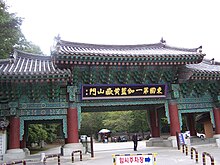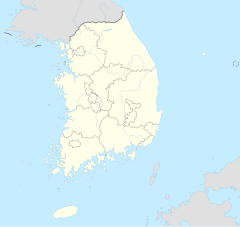Ado (monk)
| Jikjisa | |
|---|---|
| 직지사 | |

Jikjisa Temple in South Korea
|
|
| Basic information | |
| Location | 89 Bukam-gil Daehang-myeon Gimcheon city North Gyeongsang Province (Korean: 경상북도 김천시 대항면 북암길 89) |
| Geographic coordinates | 36°06′59.4″N 128°00′15.6″E / 36.116500°N 128.004333°ECoordinates: 36°06′59.4″N 128°00′15.6″E / 36.116500°N 128.004333°E |
| Affiliation | Jogye Order of Korean Buddhism |
| Country | South Korea |
Jikjisa is a head temple of the Jogye Order of Korean Buddhism. It is located on the slopes of Hwangaksan in Daehang-myeon, Gimcheon, in the province of Gyeongsangbuk-do. It may be one of the oldest temples in South Korea.
Jikjisa Temple (Korean: 직지사, Chinese: 直指寺, Pronounced “Jik-ji-sa”) was established in 418 by Preceptor Ado. There are two stories concerning this temple’s name, “Jikji (直指; literally “pointing with an index finger”). One is that Ven. Ado pointed to Mt. Hwangaksan from Dorisa Temple in Seonsan, and said, “There is also a good temple site on that mountain. The story is that in 936 when Great Master Neungyeo reconstructed the temple, he didn’t use a ruler but instead he used his own hands to measure the land and construction materials, thus, the name “Jikji.”
Mt. Hwangaksan (literally “Yellow Mountain”), on which Jikjisa Temple stands, represents the color yellow, one of the five colors that correspond to the five cardinal points. The colors black, blue, red, white and yellow correspond respectively to north, east, south, west and center. Jikjisa is located near the center of the South Korean land mass. That is why the mountain is called Hwangaksan and why Jikjisa Temple has been considered one of Korea’s foremost temples since ancient times. From Biro Peak, the summit of Mt. Hwangaksan, one can see the three provinces of Gyeongsang, Jeolla and Chungcheong. Thus it can also be said that the temple is situated at the center of three of Korea’s southern provinces.
Jikjisa Temple saw two reconstruction efforts during the Silla era. The first reconstruction, passed down as oral history, was supposedly conducted in 645 by Vinaya Master Jajang Yulsa. The second reconstruction, verified by written records, was carried out in 930 by Great Master Cheonmuk. The “Stele of Jikjisa’s Daejangdang Hall Record,” published in Daedong geumseokseo (大東金石書; Daedong Epigraphy Collection), says that Daejangdang Hall was built in 930 and that “transcripts of the entire Buddhist canon in gold ink” were enshrined there.
During the Joseon era, an earthenware urn holding the placenta from the birth of Joseon’s second king, Jeongjong, was enshrined on a Hwangaksan peak north of Jikjisa Temple which is auspicious “snake-head formation” from a geomantic perspective, making the temple the guardian of the royal placenta. Today Jikjisa Temple is the head temple of the 8th religious district of the Jogye Order of Korean Buddhism and supervises 54 branch temples scattered among the deep folds of the Baekdu-daegan Mountain Range in northwestern North Gyeongsang Province.
...
Wikipedia

